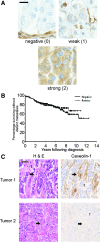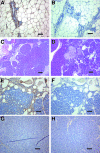Stromal cell expression of caveolin-1 predicts outcome in breast cancer
- PMID: 19411449
- PMCID: PMC2684169
- DOI: 10.2353/ajpath.2009.080924
Stromal cell expression of caveolin-1 predicts outcome in breast cancer
Abstract
Caveolin-1 has been linked to tumor progression and clinical outcome in breast cancer, but a clear resolution of its role as a prognostic marker is lacking. We assessed caveolin-1 levels in normal breast tissue and two breast cancer cohorts for which outcome data were available. We found that caveolin-1 was not expressed in normal breast luminal epithelium but was present in the epithelial compartment of some tumors. We found no association between caveolin-1 expression in the epithelial compartment and clinical outcome. However, high levels of caveolin-1 in the stromal tissue surrounding the tumor, rather than within tumor cells, associated strongly with reduced metastasis and improved survival (P < 0.0001). The onset of mammary tumors driven by Her2/neu overexpression was accelerated in mice lacking caveolin-1, thereby supporting the observation that the presence of caveolin-1 in the tumor microenvironment modulates tumor development. These studies suggest that stromal caveolin-1 expression may be a potential therapeutic target and a valuable prognostic indicator of breast cancer progression.
Figures





Comment in
-
Quis custodiet ipsos custodies: who watches the watchmen?Am J Pathol. 2009 Jun;174(6):1996-9. doi: 10.2353/ajpath.2009.090363. Am J Pathol. 2009. PMID: 19465642 Free PMC article.
References
Publication types
MeSH terms
Substances
Grants and funding
LinkOut - more resources
Full Text Sources
Other Literature Sources
Medical
Molecular Biology Databases
Research Materials
Miscellaneous

